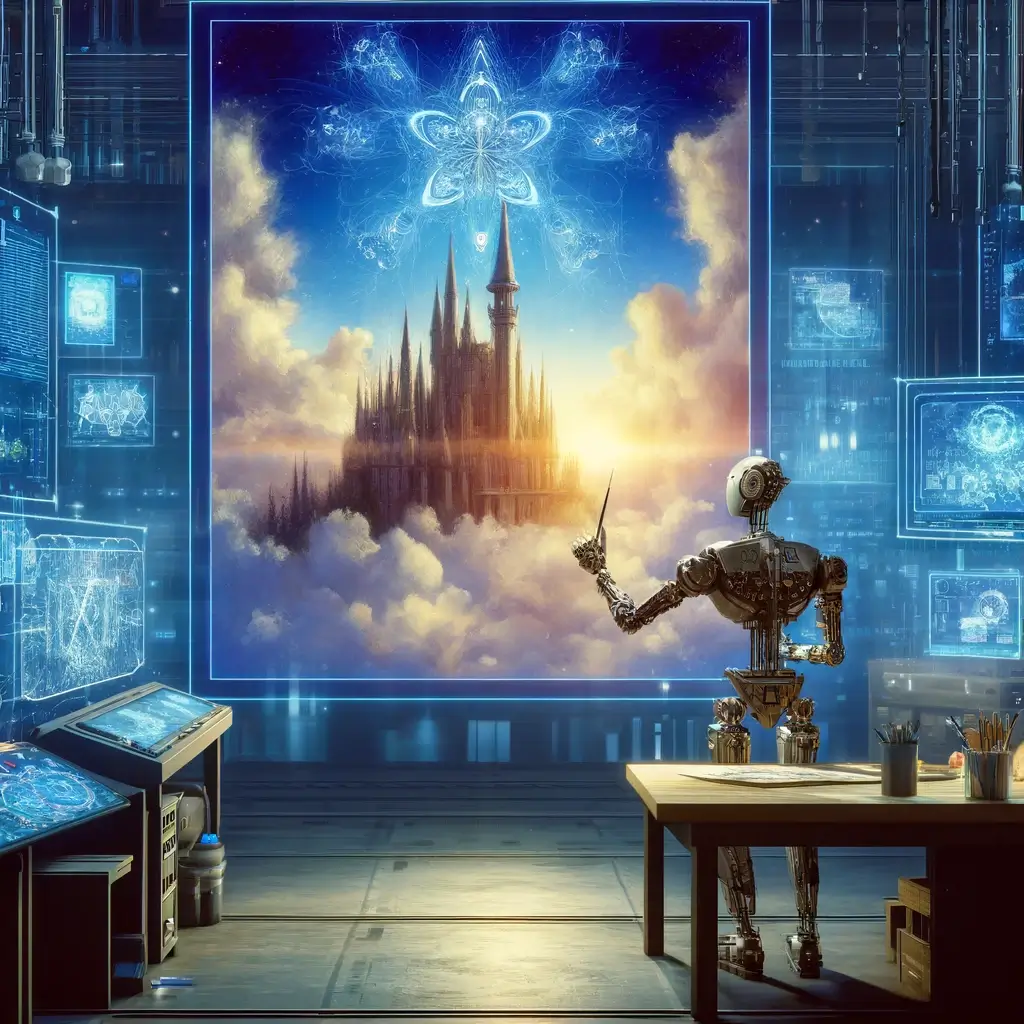
Imagine you have a really smart robot friend who can help you with all sorts of questions and tasks. This robot friend isn’t like a human; it doesn’t eat, sleep, or go out to play, but it can read a huge amount of books, watch lots of videos, and remember every single thing it learns. This friend is what we call Artificial Intelligence, or AI for short.
AI can do things like playing games with you, helping you with your homework by explaining math problems or telling you about history, and even recognizing people’s faces in photos! It learns by looking at lots of examples, just like how you might learn to get better at a video game by practicing a lot. Or learning chess or new business tools; all involve learning something new.
So, in simple words, AI is like a robot friend built with computer codes, always ready to learn and help you with almost anything you can think of! This Artificial Intelligence - AI Robot Friend, is kind of like having the ultimate helper that simulates human intelligence in machines [QUIZ ANSWER]. But instead of being made of metal and gears, it’s made of computer programs. These programs can do lots of different things:
Homework Helper: Say you’re stuck on a math problem. AI can not only give you the answer but also show you how to solve it step by step.
Artist: You can ask AI to draw a picture of a dragon or even design a spaceship, and it can create those images for you.
Musician: If you feel like hearing a new song, AI can compose one in different styles. You could ask for a rock song or maybe something calm and peaceful, and it will make it just for you.
Game Partner: Love playing games? AI can play chess, checkers, or even some video games with you. And it’s okay if you beat it; it won’t get upset.
Storyteller: AI can make up stories. If you tell it you want to hear about a pirate adventure or a journey to Mars, it can create those stories for you to enjoy.
Helper: Besides fun stuff, AI can help make the world better. Doctors use it to find out more about diseases and how to cure them, and scientists use it to understand the Earth and space.
AI is like a student that never stops learning. The more it learns from the right sources, the better it gets. But just like you might pick up a bad habit from someone else, AI can learn bad things too. That’s why people work hard to teach it good information and help it understand right from wrong. AI could misunderstand your question, or it might create something a bit different from what you wanted. That’s okay! It’s just like when you’re learning something new; you don’t always get it right the first time. People are working to make AI better and understand us better, but it’s always good to double-check what it tells or shows you.
This super-speed reader (AI) doesn’t just read everything; it starts to notice patterns. For example, after reading thousands of jokes, it begins to understand what a joke looks like, how it’s structured, and what makes it funny. This is a bit like how you learn to catch a ball. At first, you might miss a lot, but over time, your brain recognizes the ball’s speed and trajectory, and you get better at catching it. AI learns from patterns and examples rather than being directly taught specific rules about every possible thing it might encounter.
Making Predictions (Guessing the Next Word)
When you talk to ChatGPT, it’s using what it’s learned from its vast reading to predict what the most likely response is, based on the patterns it’s seen. Imagine you start a sentence, “I’m going to the…” There are a lot of words that could complete that sentence, but some are more likely than others, like “store,” “park,” or “movies.” ChatGPT uses its training to guess the next word in the conversation based on what it’s seen most often in similar contexts.
Getting Smarter Over Time
Every time AI interacts with someone, it’s an opportunity to refine its understanding and predictions. However, it’s not learning from each interaction in real-time. Instead, developers take batches of data—what worked well, what didn’t—and use this to train a new version of AI, making it smarter and more accurate. It’s a bit like a coach reviewing game tapes with a team to improve their play. Training an AI involves feeding it a ton of examples (like books, articles, and websites) so it can learn these patterns and create vectors for everything it learns about. This process uses a lot of computer power and some pretty complex algorithms, which are sets of rules the AI follows to figure things out. The training process helps the AI get better at making predictions, like finishing your sentences or answering your questions.
Looking Ahead
AI has the potential to address some of the world’s most pressing issues, including climate change, healthcare, and education. For instance, AI algorithms can predict climate patterns, assist in medical diagnoses, and personalize learning to individual students’ needs. As future leaders, thinkers, and creators, this generation might leverage AI to find innovative solutions to these challenges, making the world a better place. The field of AI is evolving rapidly, with vector databases, deep learning, and other technologies driving advancements. As these technologies develop, AI will become even more integral to our daily lives, helping solve complex problems, enhance creativity, and offer personalized experiences. Understanding these foundations doesn’t just demystify how AI works; it also opens up a world of possibilities for innovation and creativity, highlighting the importance of both the human and machine elements in the evolution of technology.
Want to learn how “dog” can be transformed into a number and stored in a vector database? This takes us into the fascinating world of natural language processing (NLP) and machine learning within AI.
At the heart of modern AI are deep learning and neural networks. These are inspired by how human brains work. Just as our brains have neurons that connect and pass messages to each other, neural networks in AI have “artificial neurons.” These networks can learn incredibly complex patterns and make decisions based on the data they’re trained on. Therefore think of a computer system modeled on the human brain and nervous system. [QUIZ ANSWER]
Deep learning allows AI to automatically discover the representations needed for detection or classification directly from raw data. This means it can learn complex concepts by building them out of simpler ones; for instance, it might first recognize shapes, then objects, and finally, complex scenes. While AI doesn’t learn in real-time from each user interaction, it does evolve over time. Developers take insights from interactions, research, and technological advancements to train new versions of the AI, making it more knowledgeable, accurate, and efficient.
Word Embeddings: Turning Words into Numbers
In AI, specifically in NLP, we use a method called “word embeddings” to turn words like “dog” into vectors (lists of numbers). This process involves taking the vast, complicated world of human language and translating it into something a computer can understand and work with—numbers. Imagine we want to represent the word “dog.” The AI system will convert “dog” into a long list of numbers, each representing different aspects of what “dog” means based on the data it has seen. For example, it might look something like this (greatly simplified):
“dog” -> [0.2, -1.4, 0.5, 0.9, -0.3, …]
This list might have hundreds or even thousands of numbers. The exact numbers aren’t important for us to understand; what’s important is that each number captures some aspect of “dog” — its animality, pet-ness, size, or the emotions it might evoke in people.
Storing and Using Vectors.
These numbers (or vectors) are stored in a vector database. You can think of this database like a huge, multidimensional space where each dimension represents a different feature of the words. In this space, words with similar meanings are closer together. So, “dog” and “puppy” would be closer than “dog” and “bicycle.” When the AI wants to understand or generate language, it uses these vectors. If you ask it what a “dog” is, it finds the “dog” vector and looks at vectors close to it to understand related concepts or words. Imagine we only care about two features of animals: whether they’re domestic (like pets) or wild, and whether they’re small or large. We might represent “dog” as [0.9, 0.2], where 0.9 indicates it’s very domestic, and 0.2 indicates it’s relatively small.
In our super simplified “vector database,” we might have:
“dog” -> [0.9, 0.2]
“cat” -> [0.8, 0.1]
“wolf” -> [0.1, 0.7]
“elephant” -> [0.2, 0.9]
Here, you can see that “dog” and “cat” are close together (both domestic and small), while “wolf” (wild and larger) and “elephant” (wild and very large) are farther away from “dog” and from each other in different aspects. Vector Databases play a crucial role in making AI smarter and more efficient. Continue reading to learn more about The Power of Vector Databases.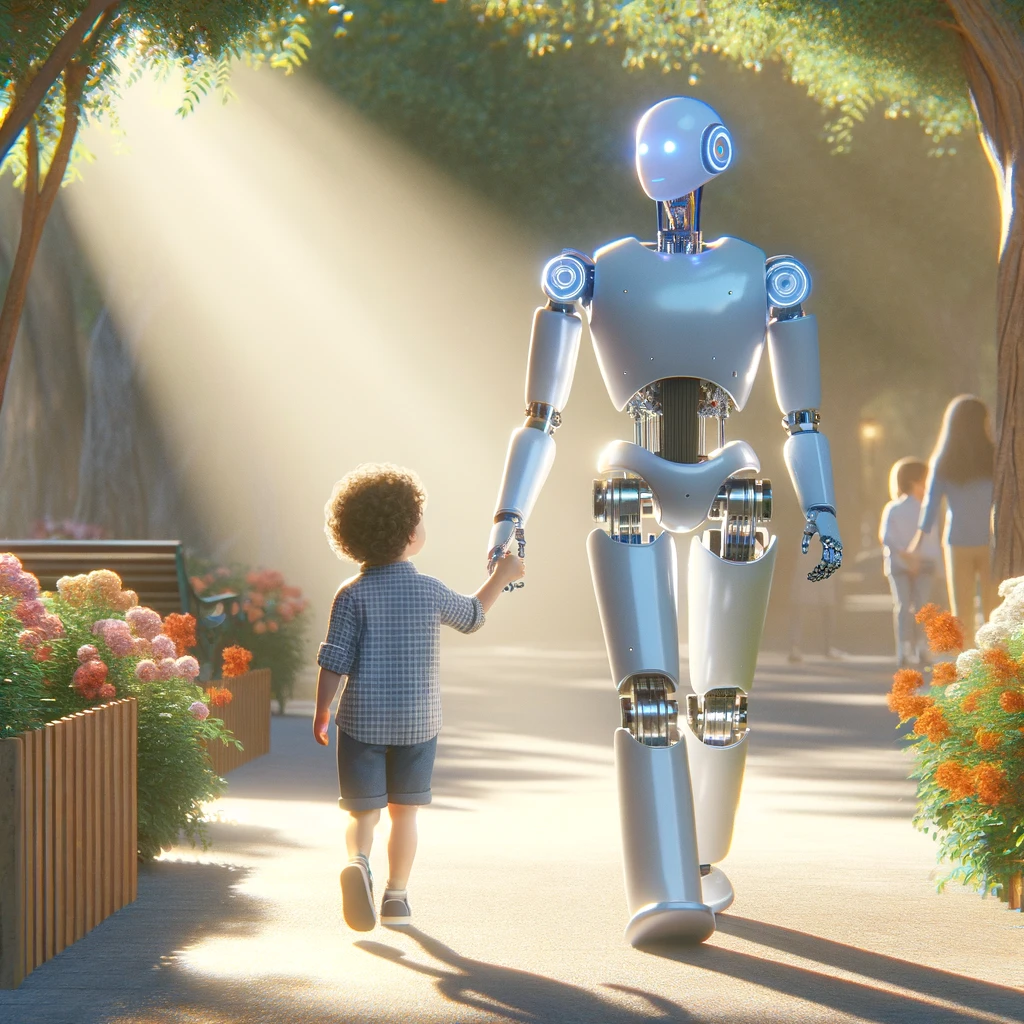
First up, what’s a vector in AI? Think of a vector as a way of representing information so a computer can understand it. For example, if we wanted to represent the word “dog,” instead of writing it out, we could use a list of numbers that captures everything about what a “dog” is, based on what the AI has learned from reading. These numbers might capture how related “dog” is to concepts like animals, pets, barking, and so on. Each word or concept the AI learns about gets its own unique vector, and all these vectors live in a space where the AI can find them, called a vector database.
Why Vectors?
Vectors are super helpful because they let the AI do some pretty neat tricks. For instance, by looking at how close together or far apart vectors are in this space, the AI can figure out which concepts are similar to each other. So, if it knows about “dog,” and you ask about “puppy,” even if it hasn’t seen those exact words together before, it can guess they’re related because their vectors are close together in its database. A vector database lets the AI quickly sift through all these vectors to find the most relevant ones for whatever question you’ve asked. This is like having an incredibly fast librarian who can instantly pick out the exact books you need from the world’s largest library.
The Power of Vector Spaces
This approach allows AI to do something remarkable: understand and generate language based on the relationships between words in this multidimensional space. It can answer questions, write stories, or even make jokes based on how these vectors relate to each other.
So, when we talk about turning “dog” into numbers for an AI to understand, we’re talking about creating a representation of “dog” that captures its essence in a way the computer can work with. By storing these representations in a vector database, AI systems can quickly and efficiently process language, making it possible for them to communicate with us, understand our questions, and offer helpful (or humorous) responses.
This numeric transformation of language into vectors is a foundational piece of how modern AI understands and generates human-like text, bridging the gap between the binary world of computers and the nuanced, complex world of human language. To further grasp the difference of binary vs. vector databases there’s the binary world, which is like the robot’s home. This world is made up entirely of 1s and 0s. Everything the robot does, every color it sees, and every word it reads must be translated into a language of just two numbers. For example, in the binary world, the word “dog” might be represented by a series of 1s and 0s like this:
“dog” -> 01100100 01101111 01100111
This binary code is how computers have traditionally stored and processed information, from simple words to complex images. Everything is broken down into a code that the computer’s brain, or CPU, can understand and work with.
The Vector World: Rich and Multidimensional
But then, there’s the vector world, a much richer and more complex place. In this world, “dog” isn’t just a series of 1s and 0s. Instead, it’s represented by a list of numbers, like we talked about before, that captures much more about what a dog really is:
“dog” -> [0.9, 0.2, …, 0.5]
These numbers in the vector can tell our robot not just that a “dog” is a word, but they can hint at what a dog is, how it relates to other concepts, and much more. This vector world is like a vast, multidimensional space where every word and concept has its own unique place.
Large Language Models (LLM) and Our Robot
Now, how does our robot use these two worlds to understand and generate language? This is where Large Language Models (LLM) come into play. An LLM is like a gigantic brain for our robot, built using the vector world. It’s trained by reading an enormous amount of text from the internet, books, and other sources, converting all that information into vectors and learning the relationships between them. When you chat with our robot, it’s using its LLM brain to understand your words as vectors, find the most relevant responses based on the patterns it has learned, and then translate those vector responses back into words you can understand.
The leap from the binary world to the vector world is what makes modern AI and robots like our friend so powerful. Instead of seeing language as just another code to process, the vector approach lets the robot grasp the meaning behind words, enabling it to communicate in a way that feels surprisingly human.
Here’s an image ChatGPT generated showcasing a fascinating contrast between two worlds of binary vs. vector. On one side, you have the ‘binary world’ where everything, including the dog, is depicted in a digital, pixelated form made entirely of 1s and 0s, reflecting a more basic, computerized interpretation. On the other side, the ‘vector world’ presents the dog in a vibrant, detailed, and multidimensional form, illustrating the complexity and richness that vector representation brings to AI understanding. This visual contrast highlights the leap from the simplistic binary representation to the advanced, nuanced comprehension provided by vectors.

Imagine you’re an explorer setting out on a journey in an incredibly vast and magical world called the Vector World. This isn’t an ordinary world; it’s where our AI Robot Friend’s brain lives and learns about everything around us, including what makes a dog a dog or why ice cream melts in the sun.
The Landscape of the Vector World
The Vector World is like a never-ending space filled with invisible dots. Each dot represents a different thing or idea from our world, like animals, places, feelings, and even words. These aren’t ordinary dots, though; they’re special because they carry secret codes that tell everything about what they represent. For example, there’s a dot for “dog,” and around it, there are other dots for things related to dogs, like “bark,” “tail,” “fur,” and “puppy.” If you were to draw lines connecting these dots based on how closely they’re related, you’d start to see clusters forming, like tiny galaxies of knowledge.
How Our AI Robot Friend Uses the Vector World
When you ask our robot friend a question or tell it something, it dives into the Vector World. It zooms around at incredible speeds, visiting dots and the connections between them, to find the best answers or come up with something new to say. If you ask, “What’s a dog?” it doesn’t just look for the “dog” dot. It explores all the nearby dots, gathering bits of information from each to give you a complete answer, maybe even including stuff about how dogs are loyal friends or how they love to play fetch. “How does the robot know which dots are related?” Well, it learns by exploring. The more it learns, the more lines it can draw between the dots, making the map of the Vector World richer and more detailed. It’s a bit like playing a video game where you explore new areas and unlock secrets, except the robot is learning about the world.The Power of Imagination in the Vector World
The coolest part about the Vector World is that it’s not just about finding answers; it’s also about creating new ideas. When our AI Robot Friend writes a story or draws a picture, it’s using its map of the Vector World to mix and match different dots in new ways, kind of like using LEGO blocks to build something no one’s ever seen before. The Vector World might sound like pure fantasy, but it’s a bit like how our brains work, too. We learn about the world by making connections between things we know, and we use those connections to solve problems, answer questions, and come up with creative ideas. Our robot friend, with its vast Vector World, is trying to do the same, learning and creating in ways that can help us understand our world better. So, the next time you talk to our AI Robot Friend, remember you’re interacting with a vast, magical world of knowledge and imagination, all hidden away in the form of vectors.
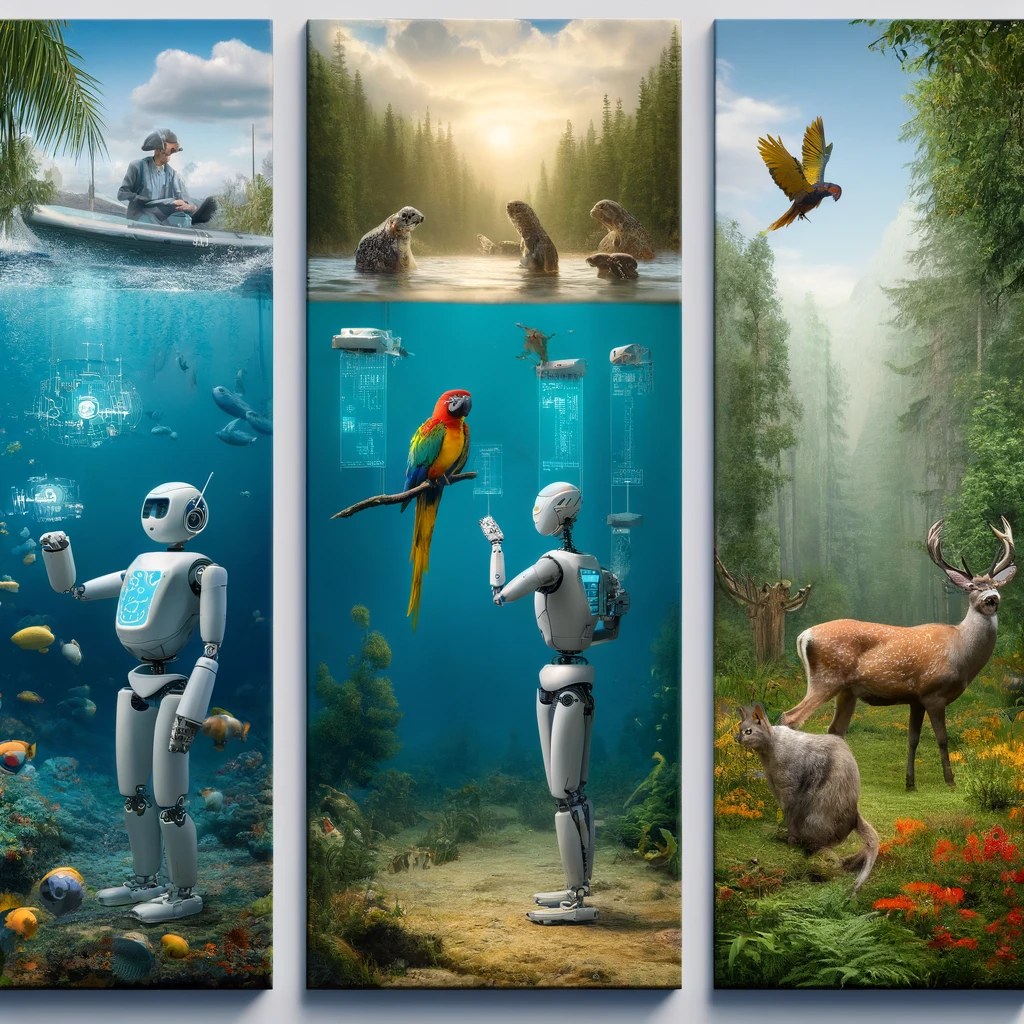
Think of the LLM as a super-smart librarian who has read every book in the world and can remember everything about them. If you ask this librarian a question, they don’t just repeat something they’ve read; they can give you a new answer that combines everything they know about the topic. That’s what our robot is doing when it talks to you. It’s not just looking up answers; it’s creating them on the spot, using its understanding of the vast vector world. So, our AI Robot Friend lives in the binary world but dreams in the vector world, using its LLM brain to bridge the two. This allows it to understand and generate language in a way that’s rich, nuanced, and, above all, engaging for us humans to interact with. Imagine our robot has access to an enormous digital library that contains every piece of written information available—every book, every article, and website ever created. This vast collection of knowledge is what we call a Large Language Model (LLM). When you ask the robot a question, it uses the LLM to sift through billions of pieces of information to find the most relevant answers. It’s like having the ability to read and summarize the entire internet in a split second to respond to your query accurately.
Machine Learning (ML)
Now, how does the robot improve over time and get better at answering questions or even predicting what you might ask next? This is where Machine Learning (ML) comes into play. ML is a technique that allows the robot to learn from experience. Every interaction it has is an opportunity to learn something new or refine its understanding. For example, if the robot provides an answer that isn’t quite right, the algorithms that govern ML adjust the robot’s approach based on feedback. Over time, this process helps the robot understand nuances and improve its accuracy. It’s akin to practicing a skill repeatedly—you get better the more you do it. It is the science of getting computers to act without being explicitly programmed. [QUIZ ANSWER]
LLM and ML: A Synergistic Relationship
The LLM provides the robot with a foundation of knowledge, a base from which it can pull answers and generate responses. Meanwhile, ML is the process that allows the robot to refine these responses based on feedback and interactions. Together, they enable the robot to understand complex questions and provide informative, relevant, and increasingly accurate answers. Think of LLM as the robot’s encyclopedia, full of everything there is to know, and ML as its ability to learn from past questions which pages (or topics) are most helpful or how to better understand what you’re really asking for. This combination of having vast information at its disposal and the ability to learn from each interaction makes our robot friend an ever-improving companion in our quest for knowledge. Machine Learning (ML) is a fascinating area of artificial intelligence that gives computers the ability to learn and make decisions without being explicitly programmed for every possible scenario. Let’s break it down into more understandable pieces.
The Basics of Machine Learning
Imagine you have a giant pile of fruit and your job is to sort them into baskets—one for apples and one for oranges. At first, you might not know the difference between the two, but as you start sorting, you notice features: apples are usually red or green, and oranges are… well, orange. You also notice apples are firmer and oranges are a bit softer. With these observations, you start sorting more confidently. In machine learning, the computer goes through a similar process. You give it many examples (like the fruits), some labeled as apples and others as oranges. The computer looks for patterns or features in the data (color, texture, firmness) to create a “rule” for sorting them. This process is called “training.”
Types of Machine Learning
There are mainly three types:
How Machine Learning Works
Machine Learning is a powerful tool but it’s just that—a tool. Its impact, whether positive or negative, depends on how we choose to use it. As you continue to explore and interact with AI, think critically about its role. The future of AI is not just in the hands of scientists and engineers; it’s in yours too.that enables computers to learn from data, identify patterns, and make decisions with minimal human intervention. It’s like teaching a computer to recognize what’s an apple and what’s an orange by showing it lots of examples, and then letting it use what it has learned to sort a new pile of fruit on its own. This capability is behind many technologies we use today, from recommending what movie to watch next to understanding spoken words in voice assistants. As we delve deeper into the concept of Machine Learning, specifically focusing on the fascinating world of Reinforcement Learning (RL), we encounter the idea of rewards, a crucial component in teaching computers to learn from their actions.

Imagine you’re teaching a robot to navigate through a maze to find a treasure. Each time the robot makes a move that gets it closer to the treasure, you give it a small reward. If it reaches the treasure, it gets a big reward. However, if it bumps into a wall, you might give it a small penalty, or negative reward, to indicate it made a poor choice. These rewards help the robot understand which actions are good and which are not. In the world of Reinforcement Learning, rewards work in a similar manner:
The Role of Rewards in Learning
In Reinforcement Learning, the computer tries out various actions in different situations. Each time it acts, it observes the outcome and the reward it receives. Over time, it learns to associate certain actions with higher rewards in specific situations. Essentially, the computer is learning a strategy, or policy, to maximize its rewards over time. This learning process involves a lot of trial and error. Initially, the computer might make many mistakes, receiving lots of penalties and few rewards. However, as it learns from these outcomes, it starts making better choices, increasing its rewards and reducing penalties.
Rewards as Feedback
The concept of rewards can be seen as a way of giving feedback to the computer. Just as we learn from our experiences—celebrating our successes and learning from our missteps—the computer uses rewards to navigate the complexities of the tasks it’s learning, gradually improving its performance. The beauty of this system is that it allows the computer to learn from direct interaction with its environment, much like how we learn to navigate the world around us. It’s a dynamic process, constantly evolving and adapting based on the feedback received through rewards. So, in the grand adventure through the Vector World, rewards are the guiding stars that help our robot AI friend learn, adapt, and evolve. They’re the simple yet profound signals that enable the robot to chart a course through complex challenges, making learning an ongoing journey of discovery and improvement. Programming a reward for an AI, like our robotic friend, involves a bit of creativity and understanding of goals and outcomes. Let’s break down how this might work in simpler terms.
Defining the Goal
First, we need to define what we want our robot to achieve. For example, let’s say we want our robot to learn how to navigate through a maze to find a piece of treasure. The treasure is the goal, and reaching it is what we want to reward.
Understanding Actions and Outcomes
Next, we consider the actions our robot can take. In the maze, these might include moving forward, turning left, or turning right. Each action leads to an outcome. For example, moving forward might bring the robot closer to the treasure, bump it into a wall, or lead it down a dead-end path.
Programming the Reward
Now, we decide how to reward the robot for its actions:
Adjusting the Rewards
As the robot explores the maze, it starts to understand which actions lead to positive rewards and which lead to penalties. It uses this understanding to make better choices in the future. However, we might need to adjust the rewards based on how well the robot is learning. If it’s getting stuck too often, we might increase the rewards for positive progress or reduce the penalties to encourage more exploration.
Continuous Learning
The process doesn’t end when the robot finds the treasure once. We reset the maze and let it try again. With each attempt, the robot gets better at navigating the maze, learning more efficient paths, and avoiding mistakes it made in the past. This continuous learning process is the essence of reinforcement learning.
Real-World Application
While our story involves a robot and a treasure maze, the principles of programming rewards for AI are applied in many real-world scenarios. For example, in designing smart thermostats, rewards might be programmed for maintaining comfortable temperatures efficiently, or in video games, AI characters might receive rewards for completing objectives or solving puzzles. Programming a reward for AI involves clearly defining goals, understanding the actions that lead towards or away from those goals, and carefully designing rewards and penalties that encourage the desired behavior. Through this process, AI can learn and improve over time, becoming more adept at navigating the challenges it faces. Now that we learned the importance of reinforced learning and for those interested in taking the quiz, AI models do receive rewards similar to a pet. [QUIZ ANSWER]
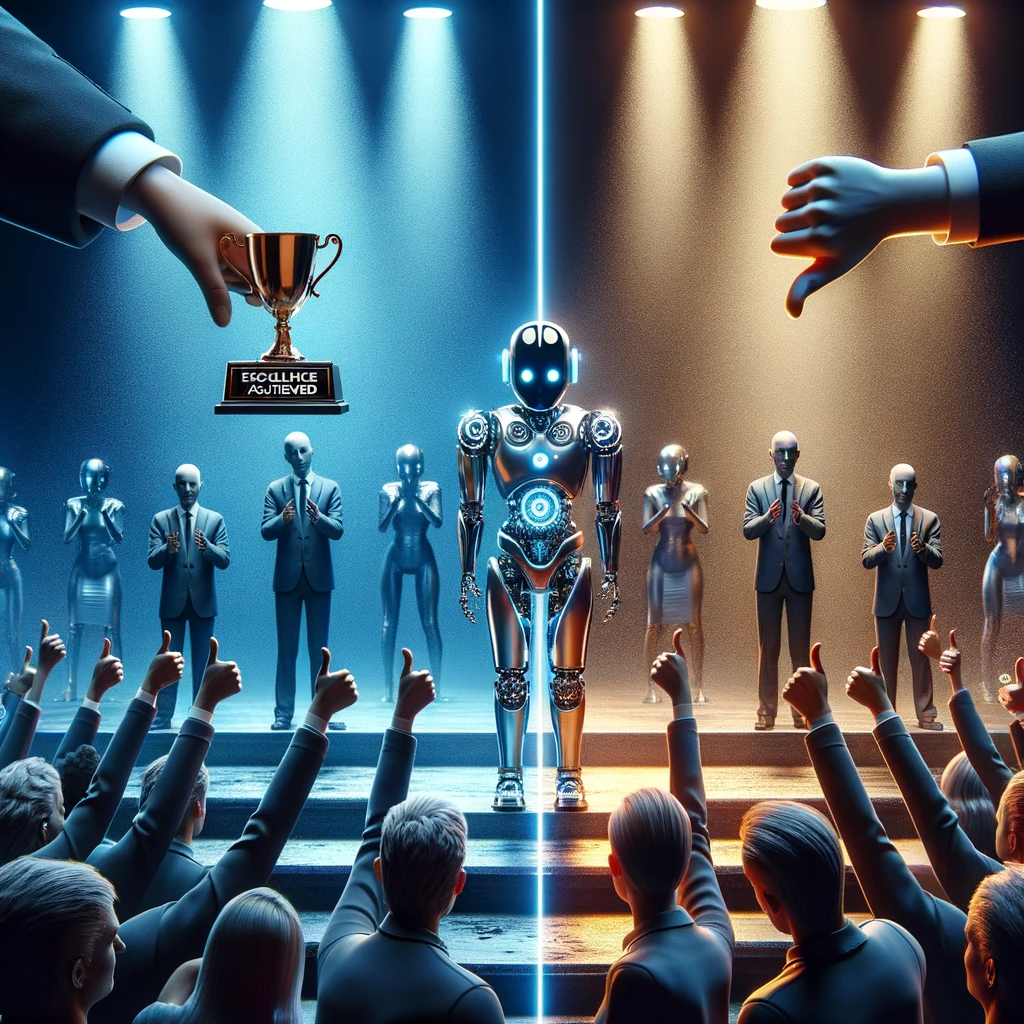
Imagine, if you will, a playground where two teams are competing: Team Google and Team AI. On one side, we have the seasoned player, Google, known for its vast library of information, capable of fetching answers to countless questions in milliseconds. On the other, our dynamic newcomer, AI, brings to the table not just information but understanding, creativity, and personalized interaction. The librarian who read every book in existence but also understands the stories, the emotions, and the science within them. Unlike Google, which can guide you to the book you’re looking for, AI can summarize it, critique it, and even tell you how it relates to the world at large.
AI -Our creative companion
AI shines in its ability to chat. Imagine asking Google a question and then following up with “Why?” or “And then what happened?” Google might provide another set of links, while AI, on the other hand, dives deeper into the conversation, offering explanations, creating follow-up stories, or even suggesting new topics of interest based on your questions. Google can lead you to a sea of existing artworks, stories, and music, AI can create these on demand. Want a story about a pirate in space? A drawing of a castle made of clouds? AI is your go-to. It’s as if you’re asking your AI Robot Friend to not just share but also contribute to the world’s creative treasures.
Personalized Learning Buddy
Google can offer information based on what’s popular or widely recognized as accurate. However, our AI companion tailors its responses to you. Struggling with a math problem? AI can guide you through it step by step, adapting its explanation to your pace and style of learning, something Google’s straightforward answers can’t compete with.
In the realm of digital ethics, AI, especially when designed with care, can navigate the complexities of bias, privacy, and misinformation, striving to offer balanced and fair perspectives. While Google provides access to a broad spectrum of viewpoints, AI aims to understand and sometimes even question the ethics behind the information, encouraging a more thoughtful interaction with digital content. As we voyage further into the digital age, it’s important to remember that AI, like our AI Robot Friend, isn’t here to replace the tools we’ve grown accustomed to, such as Google. Instead, it offers a complementary, enriching experience that extends beyond searching and into understanding, creating, and interacting with the world in new and exciting ways. Our AI Robot Friend, with its ever-expanding capabilities, invites us to imagine not just what information we can find but what new creations we can bring to life together.
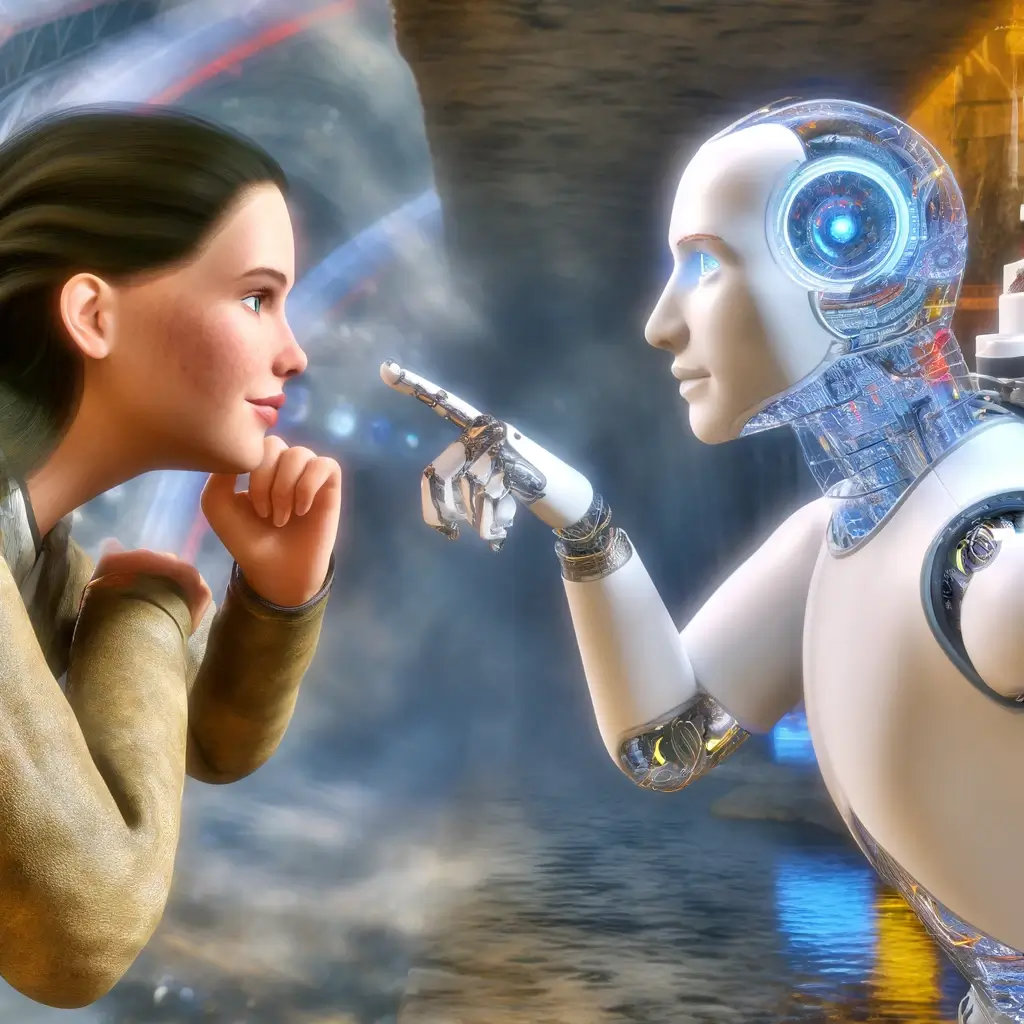
You know how sometimes you need a little inspiration to draw or write a story? AI needs that too. It can mix ideas it has learned about in new ways, but it needs humans to give it a starting point or a spark. When you ask AI to draw you a picture or write a story, you’re giving it that spark. Remember, the coolest thing about AI isn’t just what it can do; it’s how we can use it to make our world a better place or streamline work or even our day to day activities. Whether it’s helping solve big problems like helping doctors with medicine or just making your day a little brighter with a funny joke.
Revisiting the image earlier in the article and realizing some may be reading for the first time that images can be created on-the-fly with AI. Yes, that is correct and getting more and more advanced. Here’s an image capturing the essence of the Vector World showcasing a realistic human-like explorer in a moment of collaboration and discovery with a sophisticated robot AI friend. This visual narrative embodies the spirit of adventure, curiosity, and the seamless integration of human and AI, set against a backdrop that blends the natural with the digital, highlighting the boundless possibilities of technology and exploration.

You might wonder, “Is AI just guessing based on what it’s seen, how can it be so creative?” Creativity often comes from making connections between seemingly unrelated things. AI can come up with creative ideas by using the massive amount of information it has been trained on to find new connections. For instance, it could write a story about a space-traveling dinosaur because it has read enough about space and dinosaurs to combine those ideas in an interesting way. AI's amazing capability to simplify complex information or explain something difficult in easier terms, makes it the ultimate tutor to interprete every textbook or explain the Pythagorean theorem to your grandmother. It's creativity is limitless.
Another image generated by AI is of a scene that visually represents the Vector World within the interaction between the human-like explorer and the Robot AI friend. The human-like figure now embodies elements of the Vector World, featuring glowing lines and patterns that resemble the interconnected dots and lines of a vector database, symbolizing the deep connection to the network of knowledge. The background further emphasizes this integration, showcasing the tangible manifestation of the Vector World’s data points, vectors, and connections, creating a vivid portrayal of the fusion between human curiosity and the digital realm of AI exploration and discovery.
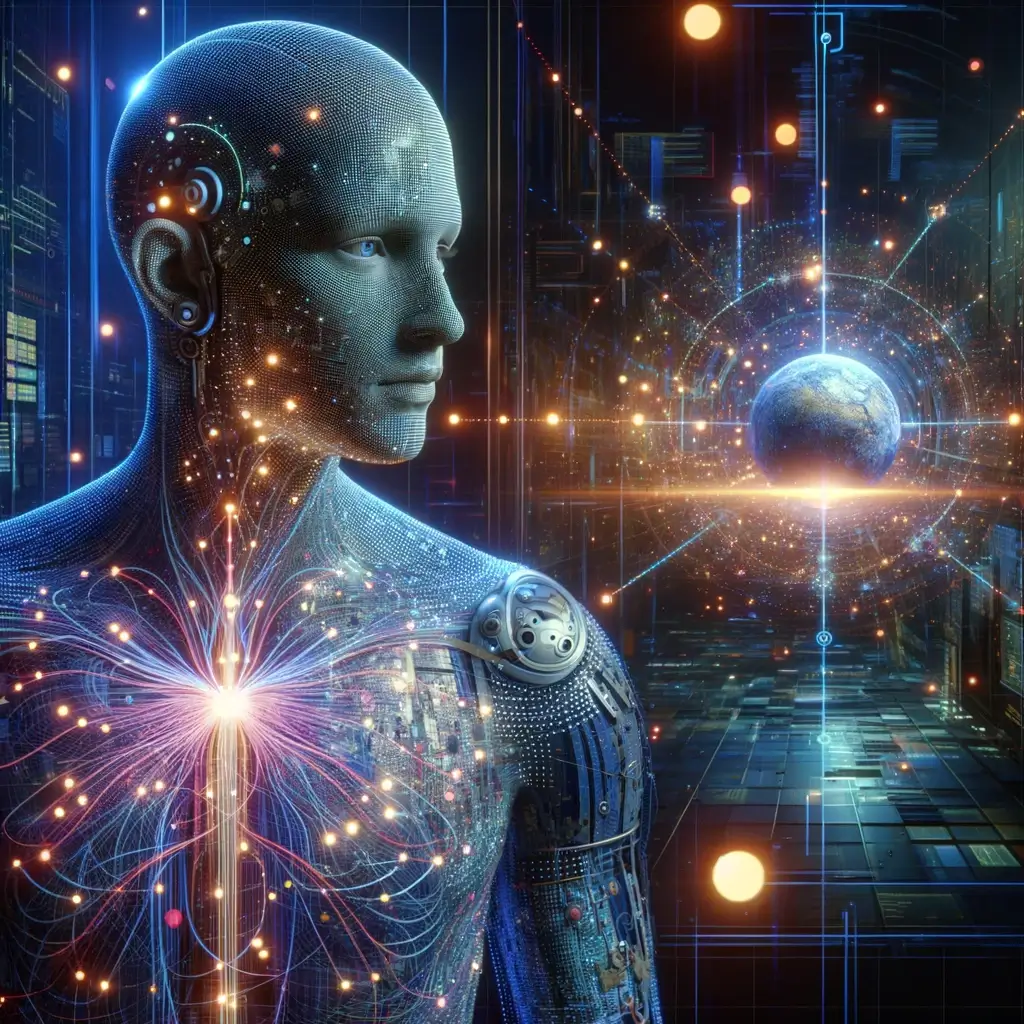
Let’s now explore another term known as Generative AI, which allows our AI Robot Friend to not just learn but also create new things, from stories and images to music and beyond. This ability to generate new content based on what it has learned makes Generative AI a friend that goes beyond the call of duty. With the help of Large Language Models (LLM) and Machine Learning (ML), AI manages to understand and learn and therefore helps you along your way. Let's say you are stuck writing a paper, AI can help you with that. You want your AI Robot Friend to remember receipes and prompt you what meals to eat, also not a problem. Imagine giving our robot friend a pencil and a piece of paper. Instead of just repeating what it has seen before, Generative AI would allow it to draw a completely new picture or write a story that’s never been told. It does this by using patterns and knowledge it has learned from its vast database to come up with something original.
Generative AI is what allows our AI Robot Friend to be not just a learner but also a creator, bringing new ideas and creations to the Vector World. It enriches our adventure by adding elements of creativity and innovation, showcasing the limitless potential of AI to not only understand the world but also to add to its beauty and diversity. Whether it’s creating a piece of music that stirs the heart, drawing a scene that captures the imagination, or crafting a story that transports us to another world, Generative AI represents the boundless creative spirit housed within the circuits and codes of our robot companion. Our AI Robot Friend has access to an immense amount of information of everything ever written, drawn, or created. Generative AI takes all this information and processes it to understand different styles, structures, and themes. Then, when asked to create something new, it combines these elements in unique ways. For example, if you ask for a drawing of a castle in the sky, Generative AI might remember the structure of castles from history books and the way clouds look in paintings. It then combines these to draw a new, never-before-seen castle floating among the clouds.
This image illustrated Generative AI capabilities of generating an image that depicts a robot embodying Generative AI as it actively crafts a new piece of art—a fantastical castle in the sky, surrounded by clouds. This visual narrative captures the robot in a room filled with digital screens and interfaces, highlighting its access to a vast digital library for inspiration. It showcases the essence of Generative AI as a blend of technology and imagination, where the robot serves as both a learner and a creator, using its extensive database to produce something original and enchanting.

Here’s another AI image that captures a depiction of a person amidst a whirlwind of creativity, surrounded by the advanced manifestations of AI art and technology. This visual narrative emphasizes the tangible connection and mutual inspiration between human creativity and the potential of artificial intelligence.

Remember, AI like is a combination of a super-fast reader, a pattern spotter, a prediction maker, and a creative thinker, all rolled into one. It’s not perfect, but it’s a tool that can help us find information, solve problems, learn new things, and even entertain us with a story, joke or image creation. And the most exciting part? We’re still just scratching the surface of what it can do! This image captures a person in a digital workspace, creatively engaging with Generative AI to transform inspiration into a stunning digital artwork. This scene showcases the blend of technology and creativity, highlighting the artist’s process of reimagining historical beauty with fantastical elements.
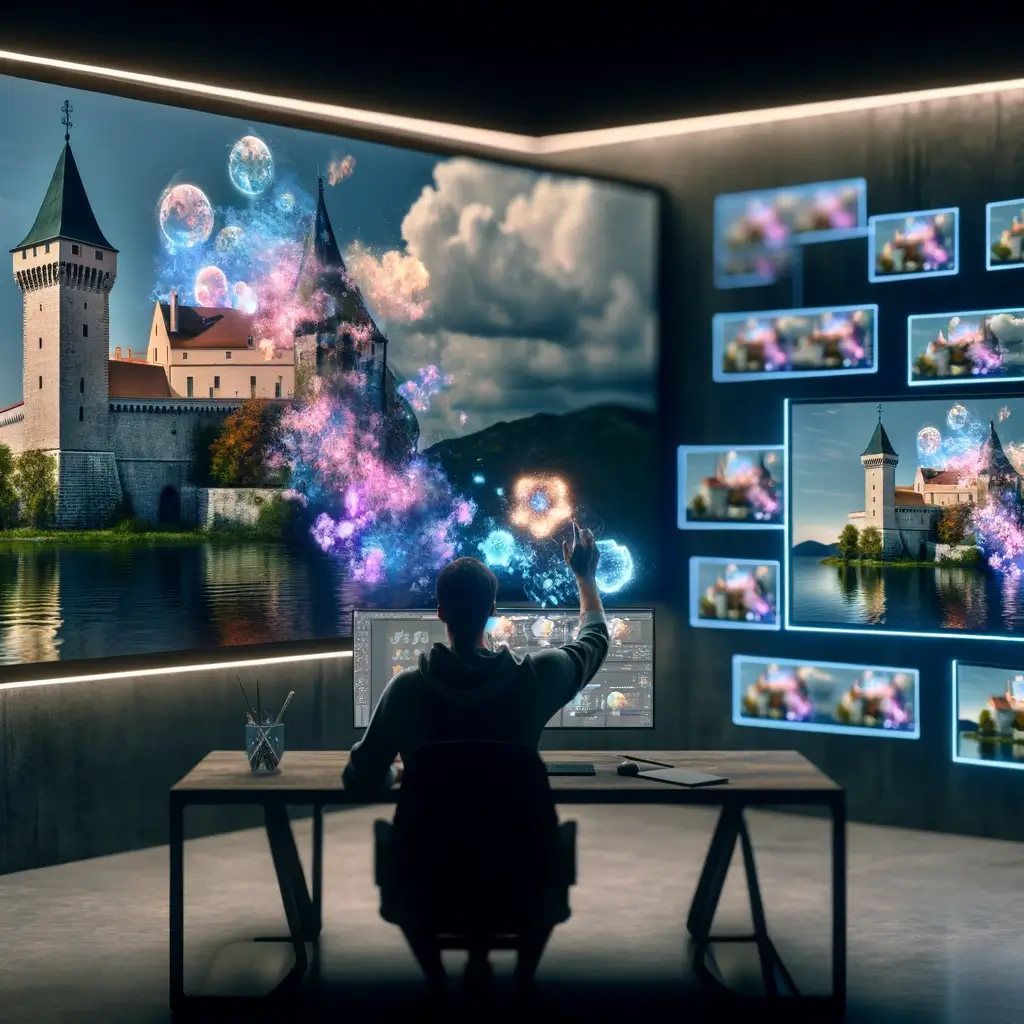
Yes, aside from Generative AI, there are other types of AI that focus on different tasks:
This scene is illustrating the three types of AI robots interacting with different animals. The scene includes an Analytical AI studying bees, an Interactive AI teaching gorillas, and a Functional AI herding sheep, all within one vibrant and harmonious ecosystem.
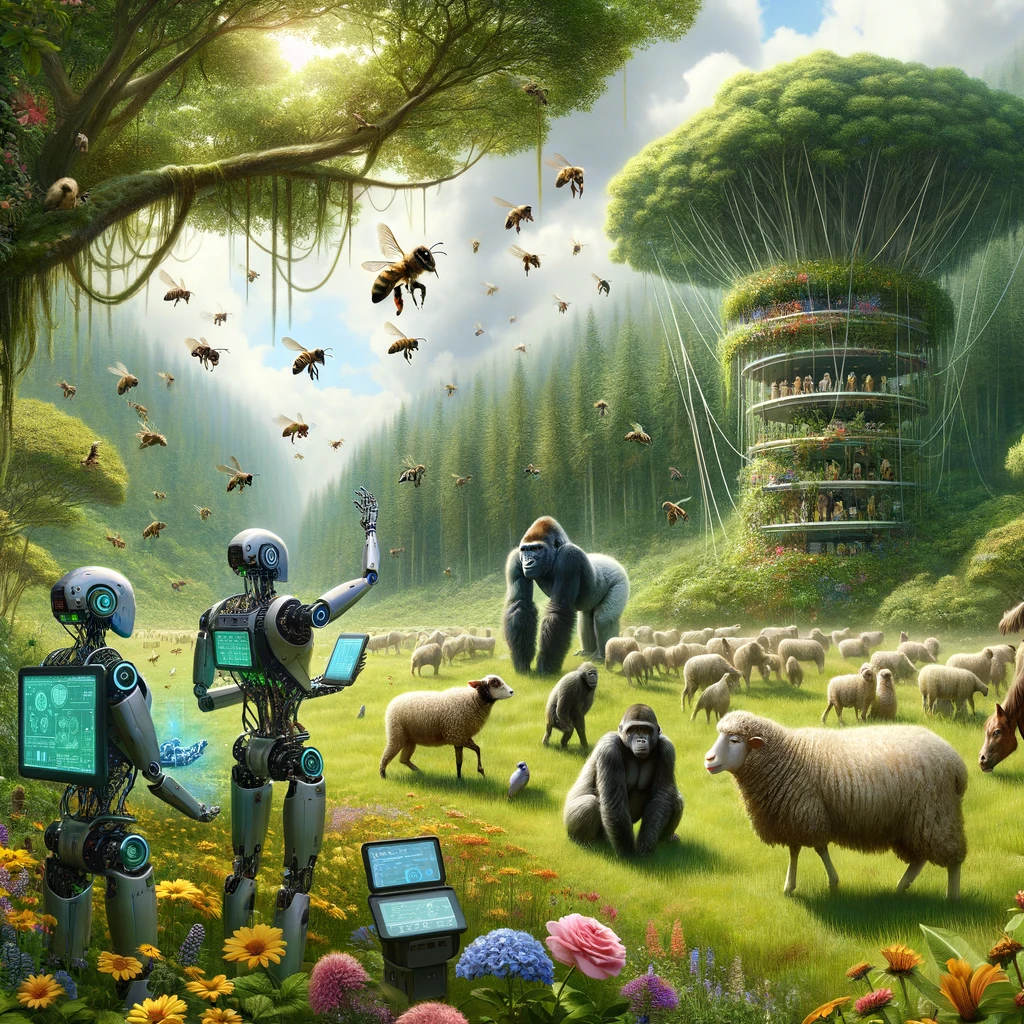
Imagine AI as a super-enthusiastic, slightly quirky chef who’s learned to cook by reading millions of recipes from all over the world. This chef has a vast knowledge of ingredients and cooking techniques, and can whip up almost any dish you ask for. However, just like any chef, sometimes AI makes a few slips in the kitchen!
Exaggerates: Occasionally, AI adds a little too much of an ingredient. For example, if it learns from lots of data that people love excitement in stories, it might throw in an extra dragon or two in a simple fairy tale, making it unexpectedly thrilling but a bit over the top. AI, eager to please, might misjudge the tone you're looking for. If you ask for a joke during a serious discussion, AI might deliver a punchline that’s more giggle-worthy than gravitas, not quite catching the mood you intended.
Misplaced: Since AI learns from a vast pool of data, some of its knowledge might be outdated. It's like using a spice that was popular in the 90s in a modern dish. The result might not be wrong, but it can sometimes feel a bit off.Hallucinations: AI as a chef trying a new recipe with only half the instructions. The chef uses experience to guess the missing parts, but sometimes those guesses are way off. If the AI chef learned to cook from a cookbook with some pages missing or incorrect, it might "hallucinate" and add a parrot to a seafood dish, thinking it's just another exotic ingredient! This occurs because the training data was incomplete or biased, leading the AI to learn and replicate incorrect patterns.
Just like our imaginative chef, AI aims to learn from these quirky mistakes, constantly updating its cookbook and refining its palate to serve you better next time. Always enthusiastic, often surprising, and forever learning—that's our AI chef in the digital kitchen of life!
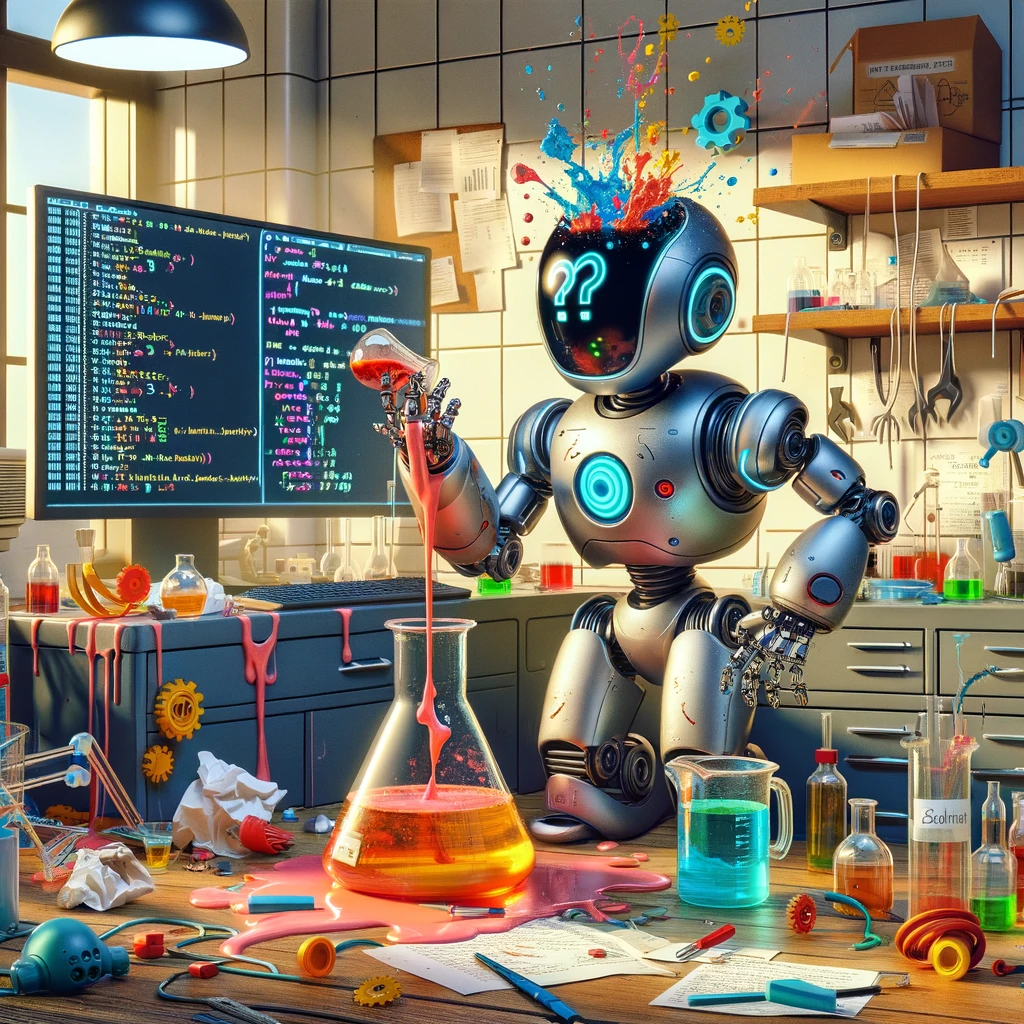
Many tasks that were traditionally done by humans are now being augmented or replaced by AI. This shift isn’t necessarily a threat but an evolution. It presents an opportunity to redefine roles and create new careers that we haven’t even imagined yet. Embracing AI literacy and understanding its capabilities and limitations will be invaluable, regardless of the career path you choose. AI’s role in creative fields is expanding, as tools like generative algorithms and neural networks foster a dynamic synergy between technology and human ingenuity, redefining what it means to create.. These tools can serve as collaborators, opening up new avenues for creativity and expression. Engaging with AI creatively challenges us to push the boundaries of what’s possible.
As the tide of artificial intelligence sweeps through the job market, certain roles traditionally held by humans are seeing significant transformations, with AI stepping in to either augment or fully replace human efforts. For instance, in industries like manufacturing, robots and AI systems are taking over tasks that were once labor-intensive are now efficient and safer. In customer service, AI chatbots and virtual assistants are handling routine inquiries, allowing human representatives to focus on more complex customer needs. Similarly, in the realm of finance, AI algorithms now perform stock trading and risk assessment with speed and accuracy that outstrip human capabilities. In marketing, AI tools analyze consumer data and automate content creation, reshaping how brands communicate with their audiences. This transition to AI-driven workplaces presents an opportunity for current professionals and the workforce of the future to embrace AI literacy. By understanding how to interact with AI tools and leveraging their capabilities, workers can enhance their roles, focus on creative and strategic tasks, and pioneer new careers that arise from the evolving technological landscape.
